
A cartridge, also known as a round, is a type of pre-assembled firearm ammunition packaging a projectile, a propellant substance and an ignition device (primer) within a metallic, paper, or plastic case that is precisely made to fit within the barrel chamber of a breechloading gun, for convenient transportation and handling during shooting. Although in popular usage the term "bullet" is often used to refer to a complete cartridge, the correct usage only refers to the projectile.

A rim-fire is a type of metallic cartridge used in firearms, where the primer is located within a hollow circumferential rim protruding from the base of its casing. When fired, the gun's firing pin will strike and crush the rim against the edge of the barrel breech, sparking the primer compound within the rim, and in turn ignite the propellant within the case. Invented in 1845, by Louis-Nicolas Flobert, the first rimfire metallic cartridge was the .22 BB Cap cartridge, which consisted of a percussion cap with a bullet attached to the top. While many other different cartridge priming methods have been tried since the early 19th century, such as teat-fire and pinfire, only small caliber rimfire and centerfire cartridges have survived to the present day with regular use. The .22 Long Rifle rimfire cartridge, introduced in 1887, is by far the most common ammunition found in the world today in terms of units manufactured and sold.
Savage Arms is an American gunmaker based in Westfield, Massachusetts, with operations in Canada and China, PRC. Savage makes a variety of rimfire and centerfire rifles, as well as Stevens single-shot rifles and shotguns. The company is best known for the Model 99 lever-action rifle, no longer in production, and the .300 Savage. Savage was a subsidiary of Vista Outdoor until 2019 when it was spun off.
The .256 Winchester Magnum is a firearms cartridge developed by Winchester, and was produced by necking-down a .357 Magnum cartridge to .257 diameter. It was designed for shooting small game and varmints.

The .22 Hornet or 5.6×36mmR Hornet is a varminting, small-game hunting, survival and competition centerfire rifle cartridge commercially introduced in 1930. It is considerably more powerful than the rimfire .22 WMR and the .17 HMR, achieving higher velocity with a bullet twice the weight of the .17 HMR bullet. The Hornet also differs significantly from these in that being a centerfire cartridge makes it reloadable, and thus more versatile. It was the smallest commercially available .22 caliber centerfire cartridge until the introduction of the FN 5.7×28mm.
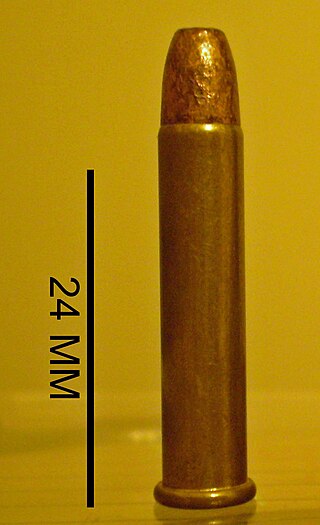
The .22 Winchester Magnum Rimfire, also known as the .22 WMR, .22 Magnum, .22 WMRF, .22 MRF, or .22 Mag, is a rimfire cartridge. Originally loaded with a bullet weight of 40 grains (2.6 g) delivering velocities in the 2,000 feet per second (610 m/s) range from a rifle barrel, .22 WMR is now loaded with bullet weights ranging from 50 grains (3.2 g) at 1,530 feet per second (470 m/s) to 30 grains (1.9 g) at 2,200 feet per second (670 m/s).
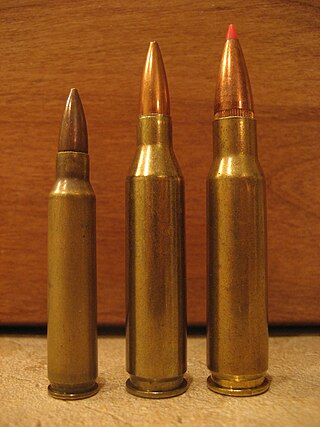
The .243 Winchester (6×52mm) is a popular sporting rifle cartridge. Developed as a versatile short action cartridge to hunt both medium game and small game alike, it "took whitetail hunting by storm" when introduced in 1955, and remains one of the most popular whitetail deer cartridges. It is also commonly used for harvesting blacktail deer, pronghorns and mule deer with heavier rounds, and is equally suited to varmint hunting with lighter rounds. The .243 is based on a necked down .308 Winchester, introduced only three years earlier. Expanding monolithic copper bullets of approximately 80 to 85 grains or traditional lead rounds of 90 to 105 grains with controlled expansion designs are best suited for hunting medium game, while lighter rounds are intended for varmints.
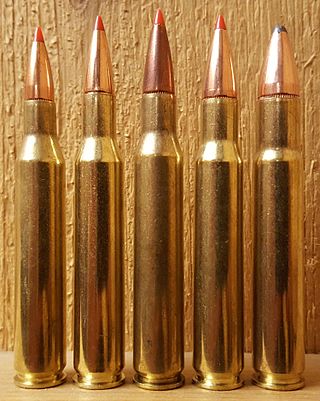
The .270 Winchester is a rifle cartridge developed by Winchester Repeating Arms Company in 1923, and it was unveiled in 1925 as a chambering for their bolt-action Model 54 to become arguably the flattest shooting cartridge of its day, only competing with the .300 Holland & Holland Magnum, also introduced in the same year.

.17 Hornady Magnum Rimfire, commonly known as the .17 HMR, is a rimfire rifle cartridge developed by Hornady in 2002. It was developed by necking down a .22 Winchester Magnum Rimfire case to take a .17 caliber (4.5 mm) projectile. Commonly loaded with a 17 grain projectile, it can deliver muzzle velocities in excess of 775 m/s (2,650 ft/s).
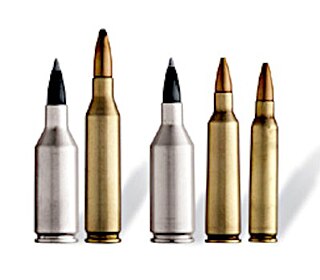
The 243 Winchester Super Short Magnum or 243 WSSM is a rifle cartridge introduced in 2003. It uses a .300 WSM case shortened and necked down to accept a .243in/6mm diameter bullet, and is a high velocity round based on ballistics design philosophies that are intended to produce a high level of efficiency. The correct name for the cartridge, as listed by the Sporting Arms and Ammunition Manufacturers' Institute (SAAMI), is 243 WSSM, without a decimal point. Winchester has discontinued the manufacture of 243 WSSM ammunition. As of the first half of 2016, Winchester/Olin did manufacture and release for sale some WSSM ammunition. The product is only manufactured periodically, often at inconsistent intervals.
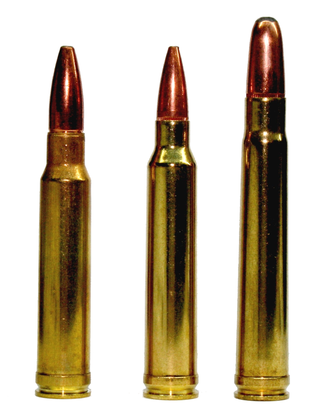
The .300 Winchester Magnum is a belted, bottlenecked magnum rifle cartridge that was introduced by the Winchester Repeating Arms Company in 1963. The .300 Winchester Magnum is a magnum cartridge designed to fit in a standard rifle action. It is based on the .375 H&H Magnum, which has been blown out, shortened, and necked down to accept a .30 caliber (7.62 mm) bullet.
The .264 Winchester Magnum is a belted, bottlenecked rifle cartridge. Except for the .244 H&H Magnum and .257 Weatherby Magnum, it is the smallest caliber factory cartridge derived from the 2.85 in (72 mm) Holland & Holland belted magnum case. It was introduced in the late 1950s and early 1960s with the .338 Winchester Magnum and the .458 Winchester Magnum as one of a family of short-cased 2.5 in (64 mm) belted magnum cartridges developed by Winchester based on the .375 Holland & Holland parent case. It was officially introduced to the public by Winchester in 1959. After many years of dwindling use it began enjoying a mild resurgence in popularity in the mid-2000s among long range rifle enthusiasts and reloaders due to the high ballistic coefficient of the heavier 6.5mm bullets and increasing popularity of cartridges such as 6.5mm Creedmoor, .260 Remington, 6.5 Grendel, benchrest and wildcat cartridges in 6.5mm.

The .223 WSSM is a .224 caliber rifle cartridge created by Winchester and Browning based on a shortened version of the Winchester Short Magnum case.

.22 caliber, or 5.6 mm, refers to a common firearms bore diameter of 0.22 inch (5.6 mm) in both rimfire and centerfire cartridges.

The 5 mm Remington Rimfire Magnum or 5 mm RFM is a bottlenecked rimfire cartridge introduced by Remington Arms Company in 1969. Remington chambered it in a pair of bolt-action rifles, the Model 591 and Model 592, but this ammunition never became very popular, and the rifles were discontinued in 1974. About 52,000 rifles and 30,000 barrels for the T/C Contender pistol were sold during its brief production run. Remington discontinued the cartridge itself in 1982, leaving owners with no source of ammunition.

The .338 Norma Magnum is a cartridge first introduced in 2008 and came into production in 2009, designed by Norma of Sweden.

.30-06 Springfield wildcat cartridges are cartridges developed from a 30-06 Springfield "parent cartridge" through narrowing or widening the cartridge neck to fit a smaller or larger bullet in an attempt to improve performance in specific areas. Such wildcat cartridges are not standardized with recognized small arms standardization bodies like the SAAMI and the CIP.

A varmint rifle is a small-caliber precision firearm or high-powered airgun primarily used for both varmint hunting and pest control. These tasks include killing three types of pests or nuisance animals that spread diseases or destroy crops or livestock:
In firearms and artillery, the primer is the chemical and/or device responsible for initiating the propellant combustion that will propel the projectiles out of the gun barrel.















